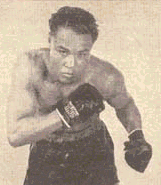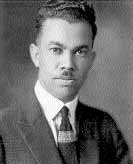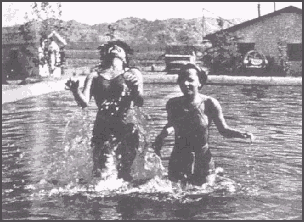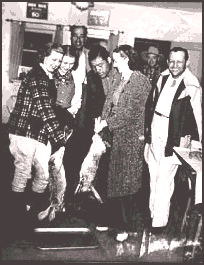

News emanated from the ranch every month after the Life Magazine story was published, and highlights from the Victor Press for the year 1938 shows the place was buzzing with activity. In January the paper made an announcement of "extensive improvements" by the Murrays which had to do with making the ranch more accommodating to adults. Ex-boxing champ Henry Armstrong visited with his wife and daughter.

By February, according to another story, the ranch was ready to handle large groups:
...now that the new houses have all been painted white with red roofs and the encircling fields planted with barley, the doors were thrown wide to a delegation of the Daughter of Elks of Improved Benevolent Protective Order of Elks of the World. |
Delegates from every Southern California district were present, and some came from as far north as Vancouver and south to Mexico. Among those attending the convention were Miss Buena V. Kelley, a representative from Virginia, and her mother, who founded the organization.
March marked Nolie and Lela's 25th wedding anniversary, and the Yucca Loma Ranch sent over a lavishly decorated cake. In April the Young People's Club, the Smart Set Social Club and the Les Bonboniere Social Club used the facilities. Despite the chilly water, wrote a reporter, Alfred Trice, manager of the Hi-De-Ho Cocktail Lounge in Los Angeles, took a swim in the pool. One prominent guest that month was Mary McLeod Bethune, founder of Bethune College in Florida, the "largest Negro institution in America."
On the Memorial Day weekend there was a large crowd at the ranch, more than 150 guests. "Strutting" Mitchell provided entertainment with his piano renditions. The famous African-American architect Paul Williams was on the guest list, along with his family.

Williams' talents were highly in demand by famous people, one of whom was auto magnate E. L. Cord, who commissioned a 32,000-square-foot house in 1929. But Williams was especially known for his work with Hollywood stars. He designed homes for Lon Cheney, Bert Lahr, Anthony Quinn, Tyrone Power, ZaSu Pitts, Frank Sinatra, Zsa Zsa Gabor, William "Bojangles" Anderson, Desi Arnaz, and Eddie "Rochester" Anderson, to name just a few.
Williams designed 300 homes in Beverly Hills alone, and many more in Bel Aire, Topanga Canyon, Brentwood, Trousdale Estates and Pacific Palisades. He designed General Hospital in Los Angeles, one of the most recognized buildings of that city, as well as the futuristic building at LAX, another of the most recognizable landmarks in Los Angeles. He had a hand in the design of the Beverly Hills Hotel, the Beverly Wilshire, and the Ambassador Hotel.
In November of 1938 the Arrowhead Springs Hotel, located in a woody area north of San Bernardino, was destroyed by fire, and Williams was commissioned to design a new building, one that would not burn so readily (three hotels had burned down in a 53-year period). He often was a guest at the ranch over the next year while he worked on the new hotel, so he obviously liked the atmosphere at Murray's.
He must have worked with lightning speed, because the new Arrowhead Springs Hotel was designed and built almost within a year of his commission, the formal grand opening ceremonies being held on December, 16, 1939. The six-story structure still stands, despite numerous fires in the vicinity over the intervening 63 years.
Local African–Americans also used the facilities of the ranch. In June of 1938, reported the Victor Press, Mrs. Lucy Thompson, one of the earliest black pioneers of the Victorville area, threw a surprise birthday party there for her husband, with 40 guests in attendance. Many of the leading blacks from San Bernardino were present, including Mrs. J. E. Mackelroy, Mr. and Mrs. H. W. Phillips, Mrs. E. V. Johnson, Arthur G. Hunter, Mrs. Florence Knight and Mrs. Bertha E. Foster.
The ranch offered a range of activities, such as horseback riding, tennis, softball, and hunting. The swimming pool was 70 feet long, and it was deep enough that once a woman came near to drowning and had to be saved by a guest. There were trips over to Dead Man's Point, a dramatic backdrop for evening wiener bakes, followed by dancing by moonlight on the dry lakes to the east.

Many of the guests were repeat customers, and the Murrays evidently took great care to insure they were satisfied with their stay. Guests from neighboring ranches began to visit, perhaps because of Malcolm Keyes, the new chef from Riverside that Nolie and Lela had hired. The meals prepared by Keyes, especially his chicken dinners, were a favorite among both black and white diners during his 18-plus years with the Murrays, and his repasts remained a favorite even after the ranch was sold and he worked for the new owners. Also enticing to guests staying at other ranches, according to one old-timer, was that the Murrays had a jukebox and was the only guest ranch with a liquor license.
A few months after the Murrays opened the dude ranch, Jeanne Godshall went over to pay her respects to them. Jeanne was the daughter of Cal Godshall, owner of the Ihmsen Ranch, which, as stated earlier, eventually became the C Bar G. Her exchange of pleasantries with the Murrays obviously promoted goodwill and business between the entire guest ranch community, and over the years a good relationship developed between the Murrays, the C Bar G, Yucca Loma, and other ranches.

Nevertheless, blacks did not stay overnight at white ranches, and whites who stayed at Murray's Ranch were ostracized. A story in a 1947 Ebony Magazine reveals that on one occasion a white writer stayed overnight at Murray's, and when the word went out he thereafter was refused a room at white ranches, and the color barrier was maintained. Other than dining, the ranch was off limits.
Ted Smith, the Bell Mountain-area resident who used to catch rides with the water truck, was recently asked in an interview if black people were welcome at the other ranches. He replied, "Not really, no. I don't think they attempted to try to go to them. I don't know of anyone turning anyone down, but you know, you don't try to push something that you know isn't acceptable." The following letter, received by the Murrays, expressed briefly how many African-Americans must have felt about having a dude ranch that welcomed them:
I am a bachelor. I like to ride horseback very much. I have always wanted to spend a few weeks on a dude ranch. Being colored, I doubted that I would ever have the chance. I was happy to learn about your ranch. Please let me know the cost of a vacation with you. |
When told that the rate for a cabin, food, and use of all the recreation facilities was only $30 a week, the writer of the letter, like most folks, could not wait to sign up.
 PAGE
1|
2|
3|
4|
5|
6|
7|
8|
9|
10|
11|
12|
13|
14
PAGE
1|
2|
3|
4|
5|
6|
7|
8|
9|
10|
11|
12|
13|
14


